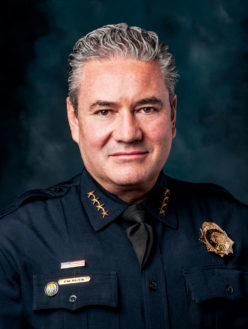
Source Details: Denver Police Department. 3-yr Avg Comparison (2019-2021.) Year-to-Date Change (2022, as of Aug. 16)
Residents throughout Denver and in our Northeast neighborhoods are concerned that the rising rates of crime are diminishing the safety of our communities—and the Denver Police chief believes a severe staffing shortage is constraining the department from being able to meet the intense demands of the soaring rates. Local crime data for 2022 offers a view of the patterns occurring in our neighborhoods, and DPD Chief Paul Pazen explains how the shortage is impacting these trends.

Denver Police Chief Paul Pazen. Photo courtesy of DPD
“We’ve already had 60 murders in Denver this year,” says Pazen, who joined the Denver Police Department in 1995 and became DPD Chief in 2018. “Our average used to be 56 murders for an entire year, and now it’s at 60, and we’re only halfway through August. For each murder, that’s a person who is gone, that’s a family that has been devastated, and that’s family members who will grieve for the rest of their lives.”
The crime data from DPD demonstrates that the rates are skyrocketing in Denver. Compared to Denver’s 2019 -2021 three-year average, in 2022 violent crimes have increased by 23 percent and property offenses have spiked by 32 percent.
The communities in Northeast Denver have also experienced rising crime in both categories. In 2022, almost every northeast neighborhood experienced increased rates for both violent crimes and property offenses. The graph illustrates the increased rates for each neighborhood.
In most communities, the increases are more pronounced for property crimes than violent incidents. The areas with the highest property crime rate increases during 2022 are Lowry, Central Park, Northeast Park Hill, and East Colfax. But some neighborhoods are experiencing disproportionate rises in violent episodes, with the most substantial spikes of violence in Montclair, Northeast Park Hill, Central Park, and South Park Hill.
The rising crime rates are triggering community meetings to discuss residents’ concerns. A Zoom meeting held by Central Park United Neighbors (CPUN) on August 16 featured a PowerPoint presentation from Lt. Kevin Hines and Officer Jesse Sandoval, who serve the District 5 area that encompasses Central Park.
The presentation helped residents better understand the crime patterns in Central Park. Auto theft is rising exponentially throughout Denver, and it is especially prevalent in Central Park, says Hines. And neighborhoods with multiple retail centers tend to have higher rates of larceny offenses.
The presentation also demonstrated that most home break-ins happen when garage doors are left open, most violent crimes relate to incidents of road rage, and most car thefts occur in long-term parking lots. Additionally, the officers emphasized that most neighborhoods in NE Denver are experiencing similar patterns, but some communities are incurring much higher crime rate increases.
Chief Pazen laments the unfortunate combination of soaring crime rates while his department is short-staffed. “Right now we are operating very thin from vacancies. We’re about 240 officers below where we need to be, and we’re short in almost every area of the department. We’re down in airport staff, traffic operations, investigative units, and every patrol district in every neighborhood.”
Chief Pazen also stresses that the vacancies in the department can hinder the responsiveness of the officers. “We’re chasing our tails going from 911 call to 911 call.” And he says at that moment he can see 17 callers on his 911 dashboard who are still waiting for officers to reach the scene. “Officers first have to finish the incidents they are on now before they can respond to these 17. Bouncing from call to call is challenging, it wears out individual police officers, and it makes it difficult to do preventative work.”
Preventative strategies can be effective because consistently seeing police vehicles on the streets can deter people from committing crimes in the area. But being understaffed impairs the ability of DPD to increase their presence and provide this deterrent.
“There are more studies and emerging research saying that countries with more police officers have lower incarceration rates,” says Chief Pazen. “If we can pre-position officers in hotspots and have that visual presence, we can prevent crime from occurring in the first place. My hope is that these evidence-based approaches can cause a shift in the paradigm to focus more on prevention.”
Chief Pazen also believes that prevention work from DPD would be beneficial for our northeast neighborhoods. “Central Park has significant challenges with auto thefts and people stealing packages. But if we have a visual deterrent, that police presence can reduce those crimes.”
“We’re hiring, and so if folks want a safer city they can consider looking at this career field. Some folks can choose to be police officers on the uniform side. But we also have professional staff that do administrative work, civilian staff that do important jobs, and those are ways people can enhance safety in their neighborhoods.”




0 Comments